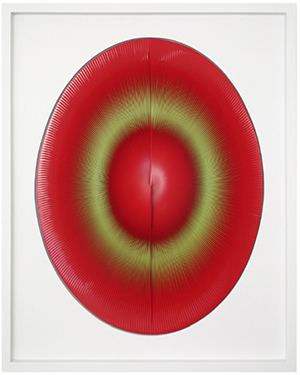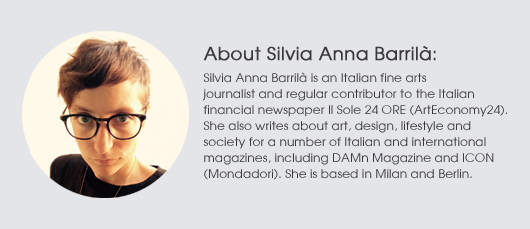
PARIS – Born in Padua in 1937, Alberto Biasi is an important representative of Italian Op Art and Kinetic Art. He came to prominence in the 1960s as a founding member of the “Gruppo N,” initiated in 1959 in collaboration with fellow artists Ennio Chiggio, Toni Costa, Edoardo Landi, Manfredo Massironi and active until 1967. In his works Biasi challenges the perception of the viewer through optical illusions, lights effects and the simulation of movement.
His first experiments in this sense were the “Trame” (wefts), superimpositions of cotton gauzes, metallic wires or perforated postcards, gradually twisted to form variable compositions. Another series Biasi started in 1960 is the “Torsioni” (twists), canvases that were cut into strips and then recomposed to form torsions. According to the angle of observation, the surface changes its appearance and seems to move. Also in his “Rilievi otticodinamici” (Optico-dynamic Reliefs), composed by lines that appear to be on the same level even though they are separated by a few centimeters, the viewer activates the image through his movement. Later Biasi created the “Ambienti” (Spaces), experimental spaces that merge the space of the work and the space of the viewer, increasing the illusionist effect and of instability.
Biasi’s value and collector base have consistently increased in the last three to four years. According to Italian art dealer Michele Casamonti, founder of the gallery Tornabuoni Art in Paris, there are two main reasons of this interest: “On one side it originates from the growing attention of many American collectors toward the European and South American Kinetic Art; on the other side Biasi benefits of the current extraordinary success of Italian art from the 1960s at the international level.”
Yet his work is still undervalued. “Biasi’s price point remains below the level of his peers in the realm of optical art, such as Jesus Rafael Soto or Carlos Cruz-Diez,” said New York-based art dealer David De Buck. “But Biasi’s work has been extremely popular among our American collector base and we expect it to reach this level due to the recent increase in interest in postwar Italian art among American and British collectors. Biasi’s market in the United States will certainly grow in the upcoming years, so his body of work in general represents a great investment.”
Also Michele Casamonti agrees. “I have no doubt that Biasi’s prices will increase in the near future. His role as a founding member of Gruppo N and his participation in the ‘Azimut’ exhibitions in 1959-60 confer an historical value to his works.”
Prices for works by Alberto Biasi vary according to a number of factors, but we can say that earlier works dating from the 1960s and 1970s are in demand and fetch higher prices, while more recent pieces dating from the last 20 years or so are particularly reasonably priced. Especially popular are pieces from the “Torsioni” series, from the “Rilievi otticodinamici” series and the works identified with the title “Gocce” (drops), which are iconic and recognizable.
Until three or four years ago, it was still possible to buy works from the 1960s for 20,000-30,000 euros. Now for these prices it is possible to buy only smaller works or works produced after the 1980s. Some of the most significant works from the 1960s have exceeded 100,000 euros.
But is it still possible to buy good works on a budget? “Yes,” said Casamonti, “and I would suggest to do it. One can still find some small-sized and more recent ‘Torsioni’ for prices around €10,000. They are small jewels.”
Biasi’s work has been included in important museum exhibitions such as the ground-breaking 1965 exhibition “The Responsive Eye” at New York’s Museum of Modern Art and the 2014 exhibition “AZIMUT/H: Continuity and Newness” at the Peggy Guggenheim Collection in Venice. Furthermore his work is in relevant collections such as the MoMA collection in New York, the Peggy Guggenheim Collection, and the Galleria Nazionale Arte Moderna in Rome.
At the end of March, two exhibitions of Alberto Biasi’s work will open: one at De Buck Gallery in New York and the other one at Tornabuoni Art in Paris. De Buck’s exhibition, titled “Unlimited Perception” and running through May 2, will be Biasi’s first solo exhibition in New York since 1971. It will feature works from the series “Torsioni” and “Rilievi Ottico-Dinamici.” Prices will range from about $40,000 to $150,000. Tornabuoni Art’s exhibition will run until June 27 and will present for the first time outside Italy Light Prism, a work that was exhibited at the Venice Biennale in 1964 and at the Palazzo delle Esposizioni in Rome in 1970.




